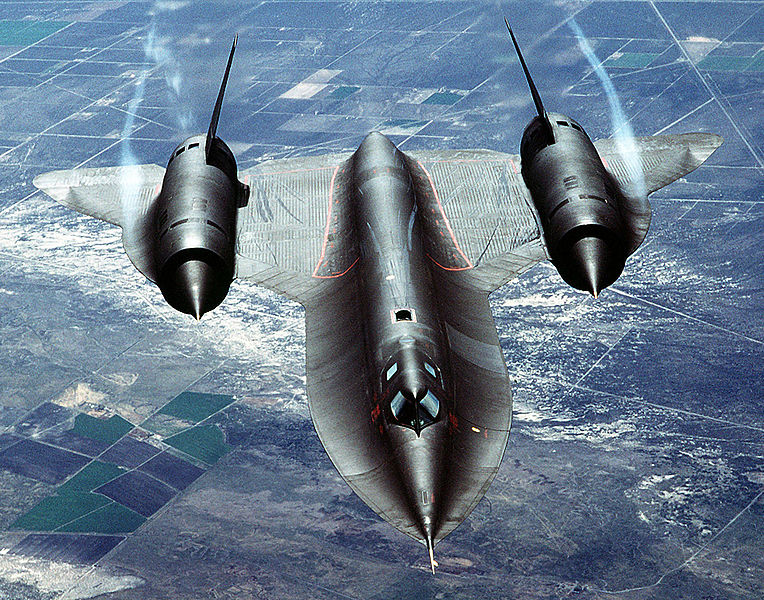
Have you ever dreamed of flying the fastest plane ever built? Then you ought to know about the SR-71 Blackbird. This stealth aircraft was designed to break the sound barrier at speeds of over Mach 3. It was so fast that none of the SR-71 aircraft were ever hit by enemy surface-to-air missiles. Read on to find out more technical information about this ultimate spy plane.
Cold War Origins
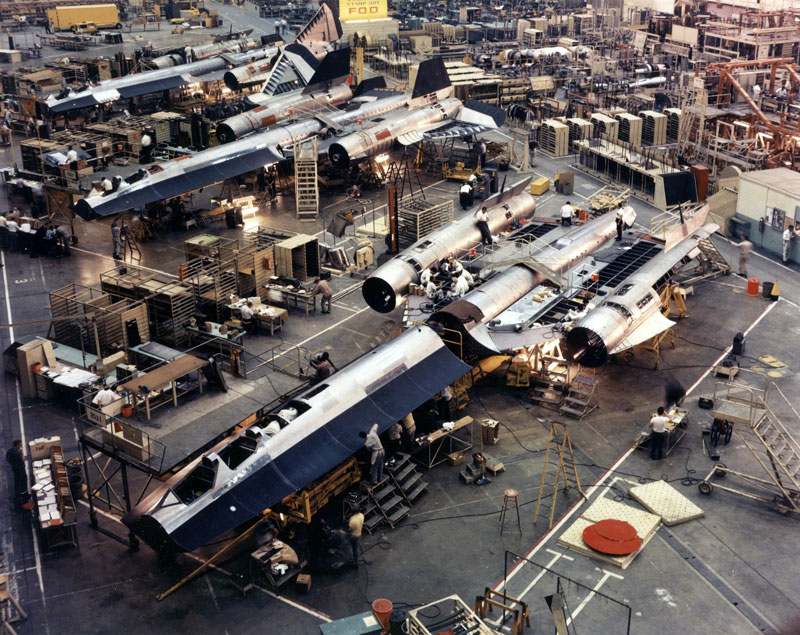
During the Cold War, the US government tasked the Skunk Works division of Lockheed Martin with a top-secret mission: build a replacement for the U-2 reconnaissance plane. The U-2, also known as the “Dragon Lady,” was hard to maneuver and slow enough to be hit by anti-aircraft missiles. The new plane was meant to overcome these weaknesses by being able to reach altitudes of 80,000 feet (24 kilometers) at speeds beyond Mach 3. The first version for the CIA was a one-seater plane called the A-12, which was used from 1962-1968. Eventually, a variant with two tandem cockpits was made for the USAF and designated as the SR-71, short for Strategic Reconnaissance. The SR-71 Blackbird was in service from 1966-1999 and was utilized by both the USAF and NASA. Only 32 units of this amazing aircraft were ever manufactured.
Shaped for Stealth

The SR-71 was built with stealth in mind, given the technology available in the 1960s. It had a flat, wide body that scattered radio waves and had chines along the fuselage, making it difficult to detect on radar. This was because the CIA did not want a repeat of the Gary Powers incident with the Soviet Union. To allow this streamlined design, the SR-71 had a falcon cross-section and did not carry any munitions. An aircraft that had a similar shape was built in the mid 80s – the Northrop Grumman B-2 Spirit stealth bomber.
Handling the Heat
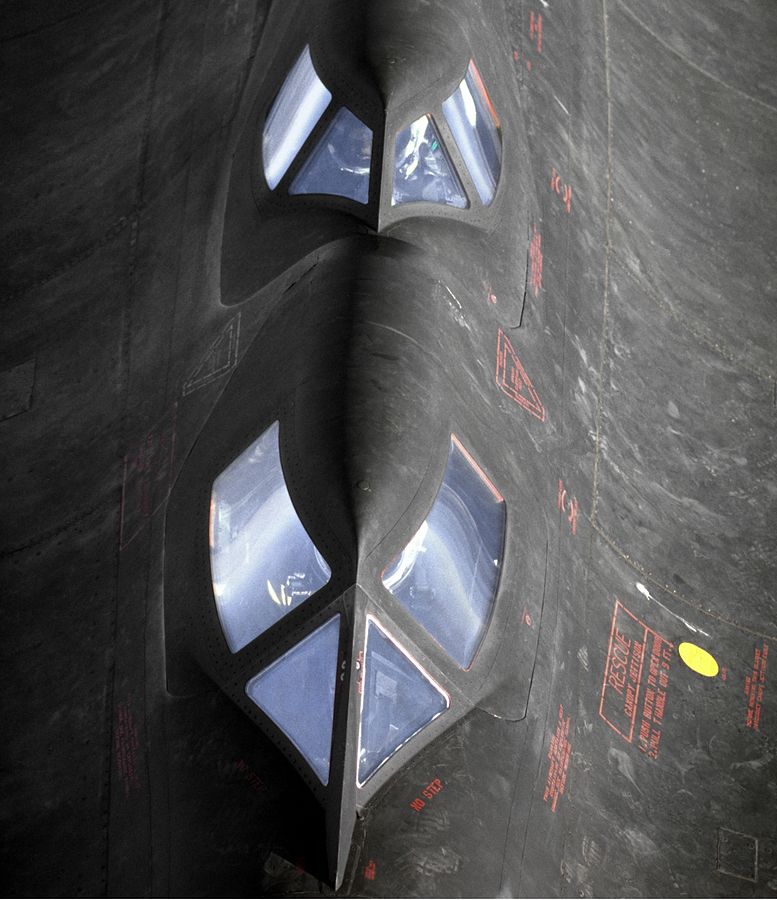
The Blackbird owes its nickname to the dark paint of its exterior, which helped camouflage the plane during night missions. More importantly, the black skin helped counteract the high temperatures of supersonic flight. How hot did it get? The leading edges reached 470 degrees Celsius (876 degrees Fahrenheit) at Mach 3, while the rest of the plane’s skin was a broiling 260 degrees Celsius (500 degrees Fahrenheit). The Blackbird’s wings had ridged surfaces, to avoid cracks or buckling caused by differential heat expansion. Around 85% of the aircraft was made of newly invented titanium alloy. Ironically, the US sourced this rare metal from the USSR, using dozens of fake companies to buy enough titanium supplies for production. Titanium was a crucial ingredient since this metal could withstand high temperatures and was resistant to corrosion. The airframe parts were also made to fit loosely on the ground, and then expand and fit more snugly when exposed to high temperatures during flight.
Refueling in Midair
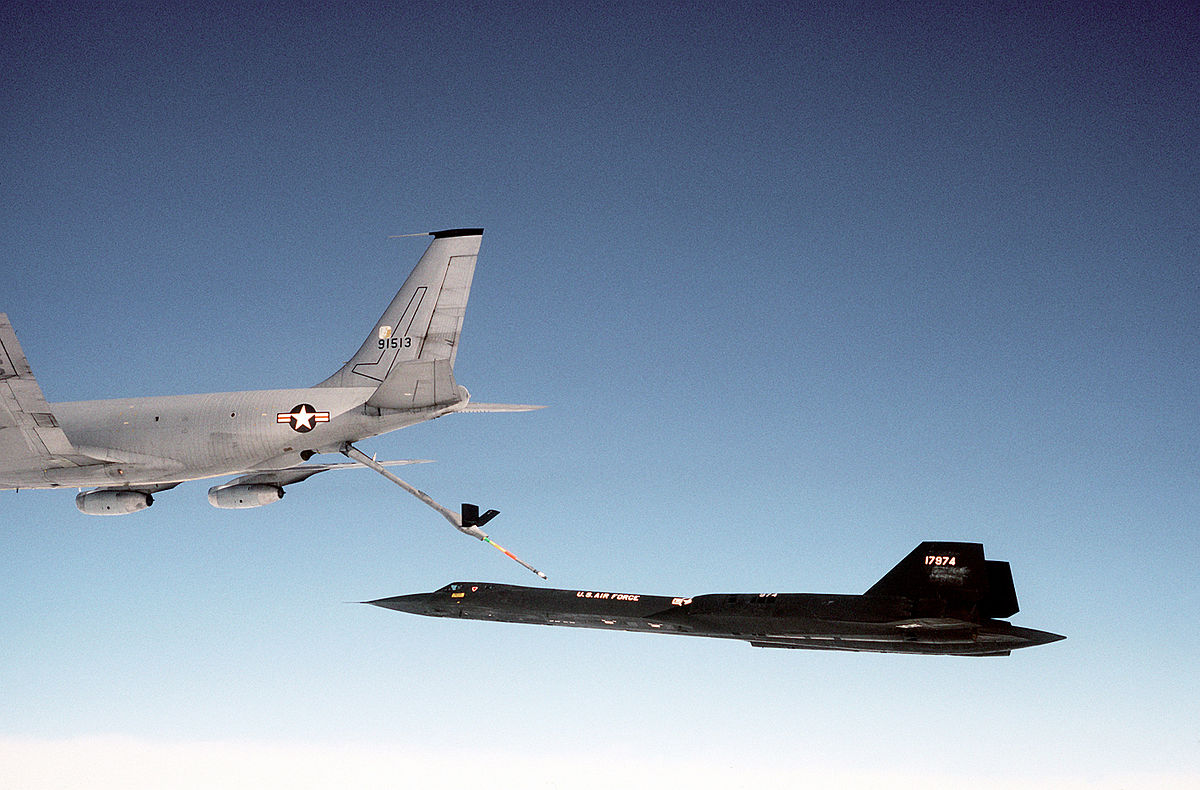
Given the extremely hot in flight temperatures of the SR-71 Blackbird, a special fuel called JP-7 was formulated for its use. JP-7 had a very high flash point, and was so difficult to ignite that a lighted match would go out if thrown into a pail filled with fuel. In order to produce a high enough temperature to ignite the JP-7, triethylborane (TEB) was injected into the engines. TEB had a very distinct green flame which could be seen in the afterburners during takeoff. Since the Blackbird’s loose airframe design allowed fuel to leak before flight, the plane had to be refueled in midair 10-20 minutes after takeoff. This was a tricky maneuver; the KC-135 tanker needed to fly at nearly maximum speed while the spy plane had to stay at near stall speed during refueling. Pilots of the SR-71 sometimes resorted to flying diagonally during this process. They needed to refuel after just 90 minutes of supersonic flight.
Supersonic Propulsion
The SR-71 had to ascend to 24 km from take-off and fly at Mach 3 for extended periods of time. For this reason, the propulsion engineers made an extremely intricate ramjet engine that could work well under the various altitudes and velocities that the plane would endure.
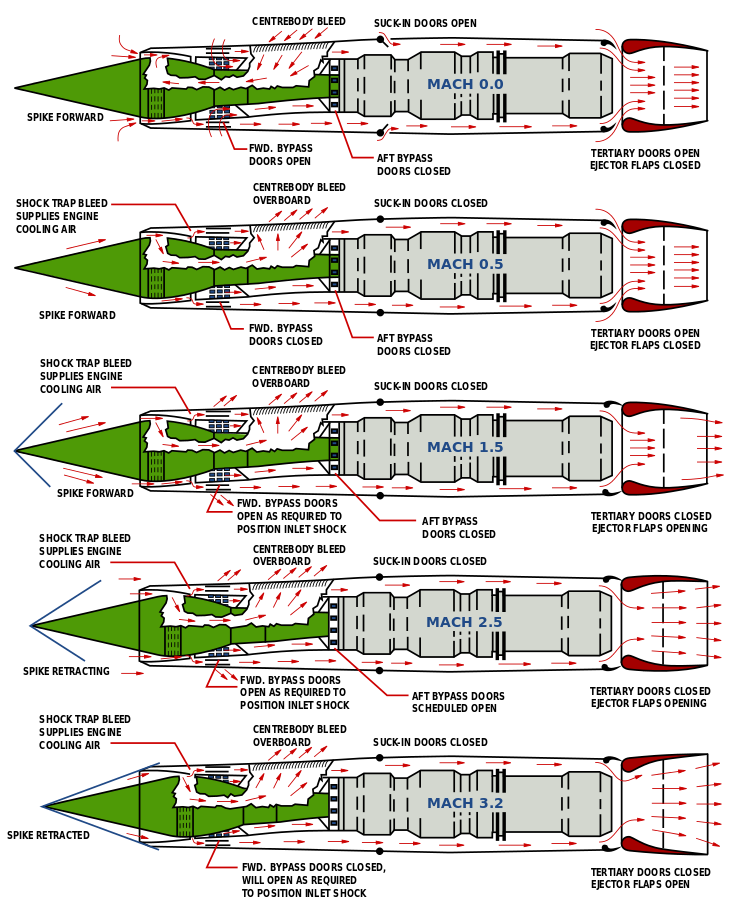
Note that Mach number as a measure of velocity is not a constant. As a measure that uses the speed of sound as its basis, it is dependent on the air temperature (only). But the plane’s behavior at, say, Mach 2 will be the same regardless of temperature.
At Mach 1 a shockwave develops. As the velocity increases, the shockwave angles downward (the blue line on the inlet cones at Mach 1.5 and up). The inlet cone was designed to be movable to position the shockwave properly, and the shockwave angle and position control the velocity of the flow. This is necessary to guarantee that the shockwaves will drop the flow velocity below the speed of sound, because combustion in a ramjet only takes place at that flow speed.
The J58 in Action
Mach 0:
The inlet spike was pushed fully forward to allow maximum airflow through the inlet. The shock wave bypass doors and the “suck-in” doors were both open to allow maximum airflow through the turbojet, maximum cooling, and these allow for the afterburners to engage.
Mach 0.5:
As the velocity increases to Mach 0.5 the suck-in doors could be closed since there was sufficient air flowing through the inlet cone. The rear doors were still left open to feed the afterburner, but the suck-in doors were closed to prevent too much air from leaving the system (notice the center body bleed is exiting the system due to higher than necessary entrance pressure).
Mach 1.5:
Now the fun would begin. The shock wave developed at Mach 1, but until the velocity reached somewhere between Mach 1.5 to 2.5 the cone did not need to move back. The ejector flaps (nozzle area) still remained at minimum since there was little air flowing through the ramjet. At this stage the turbojet was still active.
Mach 2.5:
The ram inlet began moving backward to reduce the inlet area, add oblique shock, and increase compression of the shock waves. The turbojet would be either idling, or completely off, and the nozzle would begin expanding to allow for a larger expansion ratio to keep the thrust maximized.
Mach 3.2:
The inlet cone had been moved fully back, and the inlet cross section was at a minimum. The air flow had to be slowed by 2/3 before it can enter the combustion chamber, so the pressure increased by a lot compared to the Mach 2.5 scenario. The nozzle had fully expanded to the largest exit area to help regulate exit pressure, and maximize thrust.
Note that thrust increases as the vehicle moves at a higher velocity. The faster the vehicle goes, the air compresses more. And as the pressure thrust from the under-expanded flow increased, the more pressure the body builds.
Shock Diamonds
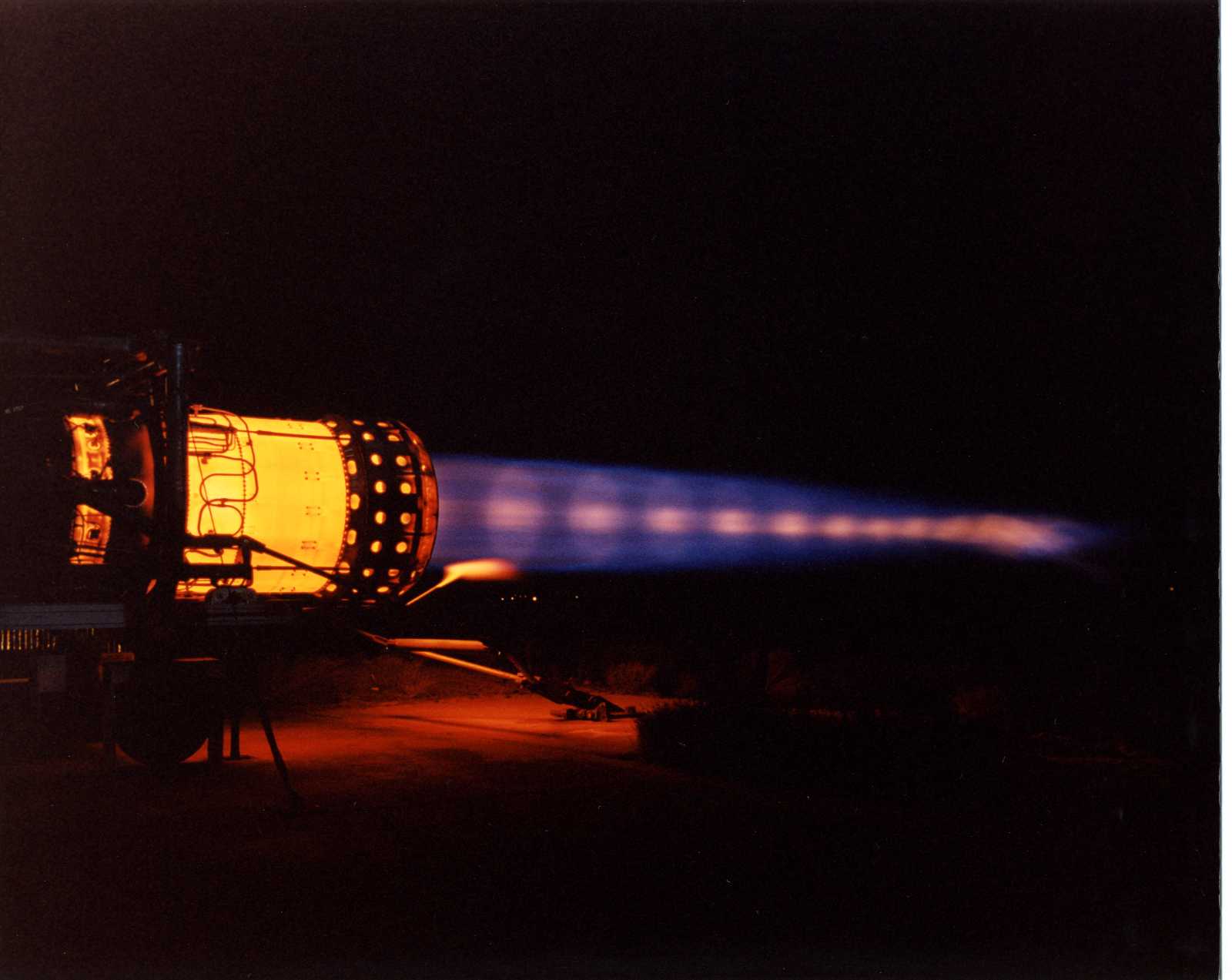
These shock diamonds were the effect of the pressure of the flow exiting the engine. If the flow is at a lower pressure than the ambient conditions, then the flow will compress and create half a diamond. Since the fluid had momentum it will compress higher than the ambient, and will then expand. That would create the second half of the diamond. This continued until the flow either drops below the speed of sound, or until the flow settles to ambient.
It also looks awesome! If you want to see how the SR-71’s engines work, watch this informative video by TechLaboratories.
Pilot Stories
So how does it feel to be at the controls of a record-breaking aircraft? Bryan Shul, a retired major of the US Air Force, shares his experiences piloting the SR-71.
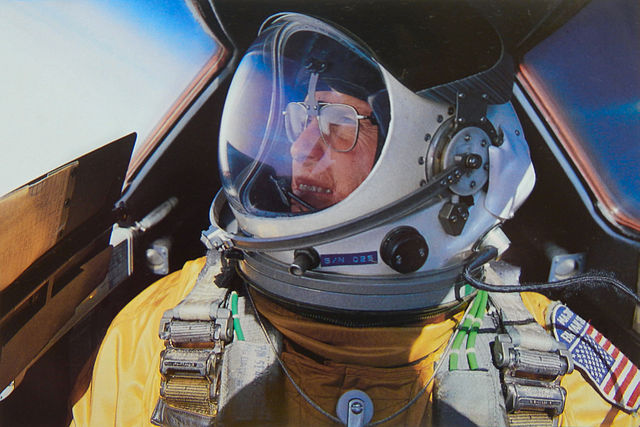
Faster than Speeding Libyan Missiles
In April 1986, following an attack on American soldiers in a Berlin disco, President Reagan ordered the bombing of Muammar Qaddafi’s terrorist camps in Libya. My duty was to fly over Libya and take photos recording the damage our F-111’s had inflicted.
I was piloting the SR-71 spy plane accompanied by Maj Walter Watson, the aircraft’s reconnaissance systems officer (RSO). We had crossed into Libya and were approaching our final turn over the bleak desert landscape when Walter informed me of missile launch signals. I quickly increased our speed, calculating the time it would take for the weapons — most likely SA-2 and SA-4 surface-to-air missiles capable of Mach 5 — to reach our altitude. I estimated that we could beat the rocket-powered missiles to the turn and stayed our course, betting our lives on the plane’s performance.
After several agonizingly long seconds, we made the turn and blasted toward the Mediterranean. ‘You might want to pull it back,’ Walter suggested. It was then that I noticed I still had the throttles full forward. We were flying well above our Mach 3.2 limit. It was the fastest we would ever fly. I pulled the throttles to idle just south of Sicily , but we still overran the refueling tanker awaiting us over Gibraltar.
And the Winner is . . .
On a typical training mission high above Arizona , we were monitoring the radio traffic of all the mortal airplanes below us. First, a Cessna pilot asked the air traffic controllers to check his ground speed. ‘Ninety knots,’ ATC replied. A twin Bonanza soon made the same request. ‘One-twenty on the ground,’ was the reply. To our surprise, a navy F-18 came over the radio with a ground speed check.
I knew exactly what he was doing. He had a ground speed indicator in his cockpit, but he wanted to let all the bug-smashers in the valley to know what real speed was. ‘Dusty 52, we show you at 620 on the ground,’ ATC responded. The situation was too ripe. In his most innocent voice, my RSO Walter startled the controller by asking for a ground speed check from 81,000 feet, clearly above controlled airspace. In a cool, professional voice, the controller replied, ‘ Aspen 20, I show you at 1,982 knots on the ground.’ We did not hear another transmission on that frequency all the way to the coast.
How Low can you Go?
I was flying the SR-71 out of RAF Mildenhall, England, with my back-seater, Walt Watson; we were returning from a mission over Europe and the Iron Curtain when we received a radio transmission from home base. As we scooted across Denmark in three minutes, we learned that a small RAF base in the English countryside had requested an SR-71 flypast. The air cadet commander there was a former Blackbird pilot, and thought it would be a motivating moment for the young lads to see the mighty SR-71 perform a low approach. No problem, we were happy to do it. After a quick aerial refueling over the North Sea, we proceeded to find the small airfield.
Walter began to vector me toward the field. Descending to subsonic speeds, we found ourselves over a densely wooded area in a slight haze. Like most former WWII British airfields, the one we were looking for had a small tower and little surrounding infrastructure. Walter told me we were close and that I should be able to see the field, but I saw nothing. Nothing but trees as far as I could see in the haze. We got a little lower, and I pulled the throttles back from the 325 knots we were at. With the gear up, anything under 275 was just uncomfortable. Walt said we were practically over the field — yet, there was nothing in my windscreen. I banked the jet and started a gentle circling maneuver in hopes of picking up anything that looked like a field.
Meanwhile, below, the cadet commander had taken the cadets up on the catwalk of the tower in order to get a prime view of the flypast. It was a quiet, still day with no wind and partial gray overcast. Walter continued to give me indications that the field should be below us, but in the overcast and haze, I couldn’t see it. The longer we continued to peer out the window and circle, the slower we got. With our power back, the awaiting cadets heard nothing.
Something told me to cross-check the gauges. When I saw the airspeed indicator slide below 160 knots, my heart stopped. At this point, we weren’t really flying, but were falling in a slight bank. My adrenalin-filled left hand pushed two throttles full forward and both afterburners lit with a thunderous roar of flame (and what a joyous feeling that was). The aircraft fell into full view of the shocked observers on the tower. Shattering the still quiet of that morning, they now had 107 feet of fire-breathing titanium in their face as the plane leveled and accelerated, in full burner, on the tower side of the infield, closer than expected, maintaining what could only be described as some sort of ultimate knife-edge pass.
Quickly reaching the field boundary, we proceeded back to Mildenhall without incident. We didn’t say a word during the next 14 minutes. After landing, our commander greeted us, and we were certain he was reaching for our wings. Instead, he heartily shook our hands and said the commander had told him it was the greatest SR-71 flypast he had ever seen, especially how we had surprised them with such a precise maneuver that could only be described as breathtaking. He said that some of the cadets’ hats were blown off and the sight of the planform of the plane in full afterburner dropping right in front of them was unbelievable. Walt and I both understood the concept of “breathtaking” very well that morning, and sheepishly replied that they were just excited to see our low approach.
As we retired to the equipment room to change from space suits to flight suits, we just sat there — we hadn’t spoken a word since “the pass.” Finally, Walter looked at me and said, “One hundred fifty-six knots. What did you see?” Trying to find my voice, I stammered, “One hundred fifty-two.” We sat in silence for a moment. Then Walt said, “Don’t ever do that to me again!” And I never did.